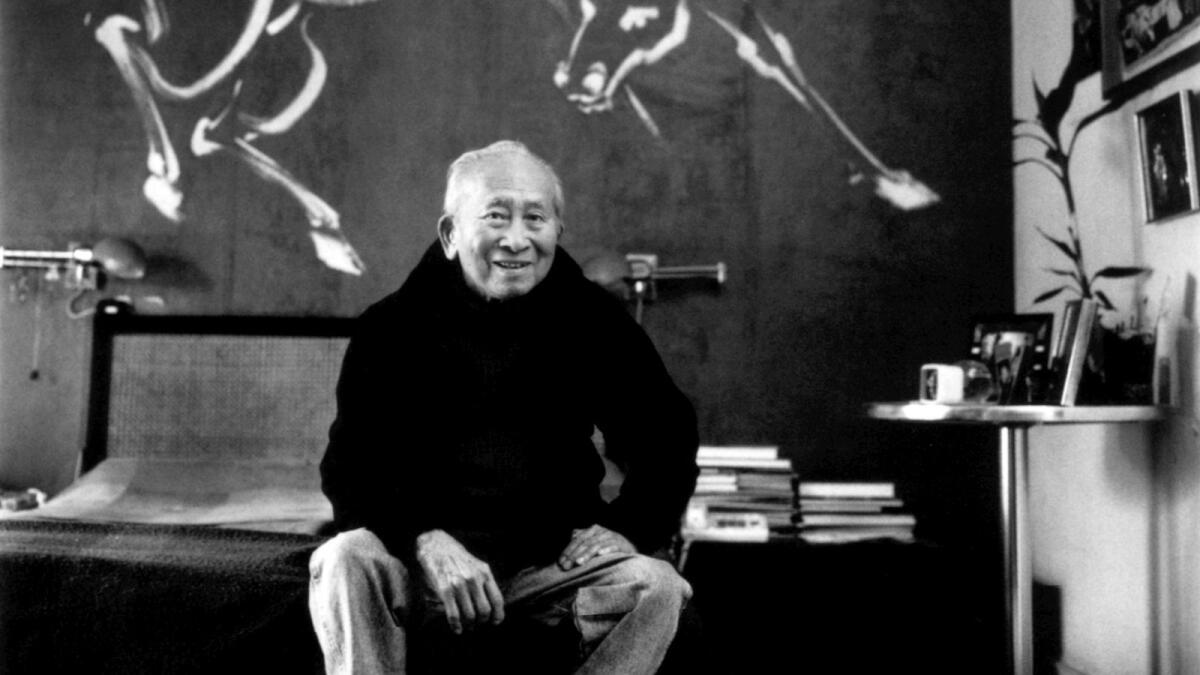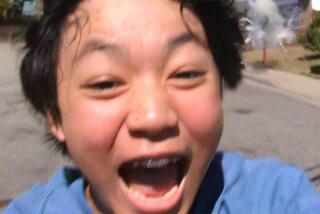From the Archives: Tyrus Wong preserves his father’s kite-making hobby

Tyrus Wong, who drew the backgrounds for Walt Disney’s “Bambi” and went on to a long and distinguished career as an artist, died Dec. 29, the Walt Disney Family Museum announced. He was 106. In this 1989 article, Wong talked to the Times about his love of making kites.
Little Tyrus Wong sat at his father’s knee one day 70 years ago outside his small home in Canton, China. The boy listened intently as his father manipulated paper and wood and paint, explaining each step. And although Tyrus understood what was happening, it nonetheless was quite magical when his father finally handed him the finished product. It was a kite. A kite shaped like a swallow.
About 10 years ago, as Tyrus Wong hit the age of 69 — and the prospect of retirement — the swallow came home to him, so to speak. Remembering his father’s careful words, his meticulous instructions, Wong rose one day and ensconced himself in the rustic studio behind his Sunland home. He sat and concentrated, remembering how his father had bent the wood, wrapped the joints firmly with string, cut the delicate paper. And again, although Wong knew what was happening, it was nonetheless quite magical when he produced the finished product.
It was a kite. A kite shaped like a swallow.
Tyrus Wong is nearly 80 years old now, and he still can be found for much of each day in the studio behind his home of 40 years, above the back-yard ravine full of whispering eucalyptus and pine trees, cooing doves and squawking blackbirds. The kites are all around him now — pinned to walls, hanging from rafters, tucked into boxes — all 200 of them.
“My God!” Wong exclaimed. “Have I really built 200?”
Yes, he really has. The swallows have grown to a flock of 25 (all flown on one line) and they have, over the years, been joined by a bevy of nine magnificent white snow cranes; a sweetly smiling angel; a snarling, multicolored 52-segment centipede more than 100 feet long; a miniature version of the same creature (it stretches to a mere 10 feet); a Day-Glo butterfly with an 8-foot wingspan; a lesser relative with a wingspan of barely 2 inches (it uses thread for kite line), and other more abstract creations that are as much flying sculptures as they are kites.
Indeed, as one admirer said: “Ty doesn’t just fly kites. He decorates the sky.”
Wong, a lifelong artist with impeccable credentials (he spent two years painting scenes for Disney’s “Bambi”), is quick to counter such poetic compliments. “Oh, one lady said she wanted to buy one a few years ago,” he said, still seeming surprised at the offer. “She said she wanted it as art — to hang on her wall! So I sold it to her. But I don’t sell the kites. I fly ‘em.”
He certainly does. On the fourth Saturday of every month, Wong and Ruth, his wife of more than 50 years, leave their home and make an early morning trek to the beach just north of the Santa Monica Pier, where the kite man of Sunland hoists his creations — along with a coterie of fellow “kite nuts” that includes a number of Wong cousins and nephews, and sometimes one or more of his three daughters.
“Oh, I love it,” he said, characteristically taciturn. “Fresh air, beautiful view, pretty girls in bikinis — it’s great!”
Wong has a lively, almost elfin presence. He directs a tour of his compact studio too quickly, matter-of-factly pointing out items that tell nothing less than the story of his life: happy family shots of wife and daughters; ancient, sepia-discolored shots of his parents in China, paint splotches that date back decades.
“There’s a picture of me that was on my passport photo when I came here,” he said. (He came to the United States in 1920.) “And there’s a picture of the steamship that we came to the United States on.” He recalled his first impression of Westerners — shipboard Americans dancing and having impromptu relay races with shoes as batons. “I thought it was so funny — it looked crazy, but they seemed to be having a lot of fun.”
Then he whirled around and pulled out a couple of large orange paper goldfish, explaining, “This is a climber . I attach them to the line that the kite is on, and they fly up, then slide back down. You see? It looks like they are kissing!”
A sinewy man with silver hair and nut-brown skin, Wong pointed almost carelessly to about 20 years worth of greeting cards that he designed for Hallmark and other companies, displayed classic Chinese paintings he has done for magazine covers, and then leafed through scrapbooks containing some of his paintings executed as guides for such movies as “Sands of Iwo Jima.”
He slowed down, finally, as he hauled out a portfolio of his original watercolors for “Bambi.” Here, for a moment, his pride showed. The paintings were used by other Disney artists and animators as blueprints for scenes in the movie.
“Oh, here’s the one that was used for early morning, where it’s misty and so forth — ethereal,” Wong said. “Here’s the beginning of the rain, setting the mood. See the kingfisher there? . . . This is where Bambi got lost. . . . This is late autumn, with the oak tree with its last two leaves, you know. Remember them talking in the movie? One drops and the other follows. . . .”
But it is the kites that are his favored children. Intricate and delicate, spectacular and subtle, they occupy Wong’s creative output almost entirely. “I use bamboo from Japan,” he said, now sounding more like scientist than artist. “The bamboo over there is better. Longer joints.” He picked up a stick and balanced it on the tip of one of his wrinkled fingers.
“I can’t use the stick in its natural form because it’s unbalanced, so I have to shave it,” he said. “I shave it down again and again until it is perfectly balanced. Look, the arc is beautiful, even.”
On a recent Saturday morning, Wong, his wife and youngest daughter, Kim Lan, made the monthly trip to Santa Monica Beach. This was not to be a typical kite outing, however. Henry Fukuhara, fellow artist and one-time fellow student at the Otis Art Institute (in the early 1930s), arrived to see his old friend for the first time in 10 years. Wong underplayed the reunion (“What are you doing here?” he smiled), but was obviously pleased to see his old friend.
Fukuhara unabashedly marveled at Wong’s dashing across the sands like a 20-year-old — unloading, flying, then repacking kite after kite. “I think he was born with that spirit,” Fukuhara said. “You have to be born with it.”
Wong reeled in a dazzling orange, black, green and yellow abstract thing with nine 40-foot tails (“Nine is a lucky number in Chinese,” he said), and approached his former colleague. “You know,” he said, mock-seriously, “we were both students at Otis, then Henry went to New York and became rich. He’s a millionaire now, and I never heard from him! He’s very successful. I couldn’t touch him with a 10-foot pole!”
Fukuhara laughed and replied: “Aw, shut up. Go fly a kite!”
And Wong did--next hoisting his prized centipede kite — all 52 segments. It writhed and twisted, a fantastic sky-snake, with yellow and blue spinning eyes, magenta tongue, long white fangs, and ears that gave it a slight resemblance to Mickey Mouse. Next was one of the tiny butterfly kites, which flew at a distance of about 30 feet, flitting and darting like, well — a butterfly.
Finally came the day’s highlight, a test flight of the snow cranes--nine graceful white birds made of nylon, bamboo and fiberglass. First, Wong dug a hole in the sand and buried his kite “anchor” (his own invention), then launched crane No. 1, jogging easily across the mostly empty beach. The morning breeze was light, and somewhat fickle, but the crane eventually climbed high enough for the artist to attach crane No. 2. And three. Then four, five, six and seven--all during the course of the next 45 minutes.
Each bird swooped and spun at the end of its own tether, each attached at different intervals to the main line. Occasionally, one would plummet earthward, only to be picked up and relaunched by Kim. Wong periodically uprooted the anchor and moved to a better spot for stronger wind, scurrying around the sand like a happy child. No. 8 went up next and, after a slight adjustment to its body structure, stayed aloft. Then the piece de resistance — No. 9.
“I’ve had 25 swallows up there at once,” yelled Wong, attaching the last crane. “But these are larger.”
No. 9 climbed, dipped, ducked, crashed once, then gradually took its place higher and higher in the sky with its eight brothers. And Tyrus Wong — artist and, for the moment, part air traffic controller — stood on the beach in Santa Monica, holding onto a line attached to what really was nothing less than an aerial ballet.
Rense is a Sherman Oaks freelance writer.
More to Read
The biggest entertainment stories
Get our big stories about Hollywood, film, television, music, arts, culture and more right in your inbox as soon as they publish.
You may occasionally receive promotional content from the Los Angeles Times.










